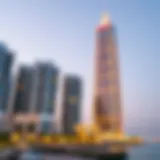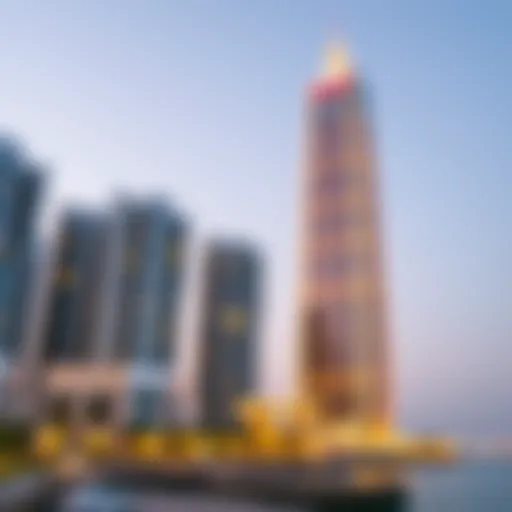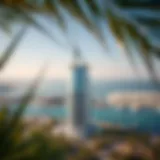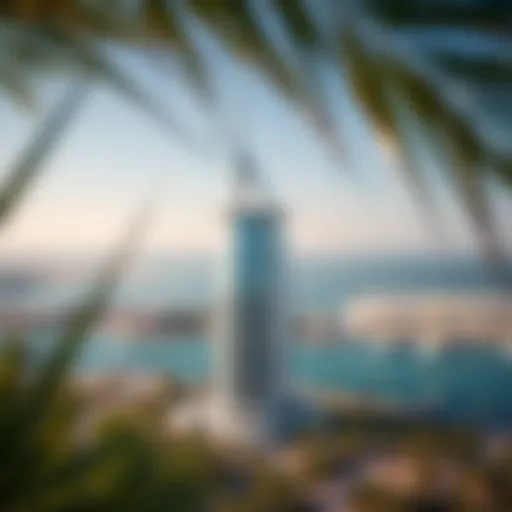Exploring Souk Naif Deira: A Hub of Culture and Commerce
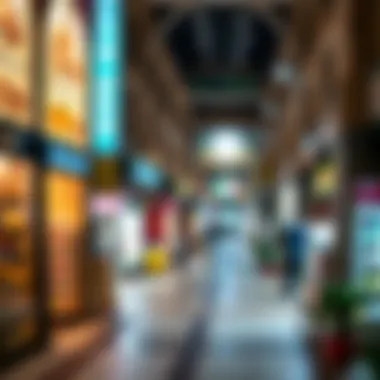

Intro
Nestled in the heart of Dubai, Souk Naif Deira stands as a vibrant testament to both the city’s rich heritage and its bustling commercial scene. Known for its eclectic mix of traditional goods and contemporary wares, this marketplace offers a unique shopping experience that attracts both tourists and locals alike. As people navigate through its narrow alleys lined with shops, they're not just purchasing items; they're engaging with a space that pulsates with culture and history.
When one steps into Souk Naif, the sensory experiences are immediate—the rich aroma of spices wafts through the air, mingling with the vibrant colors of scarves and textiles that adorn the stalls. It's a feast for the eyes and the senses, making it an essential stop for anyone in Dubai. The souk's significance extends beyond just commerce; it plays a crucial role in connecting the community and fostering an environment where traditions meet contemporary needs.
This guide seeks to uncover the layers of Souk Naif Deira, from its historical roots to current market trends, giving insight into its ongoing relevance in today’s economic landscape. Whether you're an investor looking for opportunities, a buyer in search of unique products, or simply someone with a curiosity for cultural exploration, Souk Naif offers something for everyone. Join us on this journey through a marketplace that is as much about trading goods as it is about trading stories and experiences.
Prelude to Souk Naif Deira
Nestled in the heart of Dubai, Souk Naif serves as a vibrant encapsulation of the city’s rich heritage and bustling commerce. This market is not just a place for transactions; it represents a vital cultural crossroads where tradition and modernity blend seamlessly. Visiting Souk Naif provides an opportunity to traverse through time, to witness the evolution of trade in Dubai, and to delve into the daily lives of the local community.
Souk Naif stands out in today’s world due to its unique offering—a dazzling array of goods, ranging from shimmering textiles to intricate handcrafted souvenirs. Each stall pulsates with life, creating a shopping atmosphere that is both lively and inviting. For expatriates and locals alike, this bustling market area is more than just a shopping destination; it is a reflection of socio-economic dynamics, capturing the essence of what it means to trade in a globalized world while holding strong to local customs.
Key Benefits of Exploring Souk Naif:
- Immersive Experience: Visitors get to interact directly with shopkeepers, many of whom are part of families that have traded there for generations. This enriches the shopping experience, providing insights that a mere transaction cannot offer.
- Diverse Offerings: Whether you are looking for traditional Arab attire, spices, or silverware, the souk boasts a plethora of choices that cater to every taste and preference.
- Cultural Connection: The market is often alive with local events and festivals, presenting a glimpse of Emirati culture that visitors might not find elsewhere.
Souk Naif doesn’t just cater to tourists; it also plays a significant role in the local economy by supporting artisans and small merchants. In a time when shopping moves toward online experiences, this marketplace embodies a vital connection between the past and the present, reminding us of the human element in commerce.
"To walk through Souk Naif is to journey through the heartbeat of Dubai itself."
As the city continues its rapid development, understanding the importance of markets like Souk Naif is critical for investors and developers seeking to tap into the potential of Dubai's commercial landscape. This introduction sets the stage for a deeper exploration of the historical and cultural fabric that weaves together this remarkable marketplace.
Historical Background
Understanding the historical background of Souk Naif Deira is like piecing together an intricate tapestry that reflects the essence of Dubai’s growth and transformation. This section showcases the souk’s journey through the sands of time, emphasizing its crucial role in establishing not only the local economy but also cultural dialogues among diverse communities. The historical lens adds layers of value, helping visitors appreciate the rich heritage that goes beyond mere shopping. Without this context, one might only see the souk as a market, devoid of the stories and lives interwoven within its confines.
The Origins of Souk Naif
The roots of Souk Naif can be traced back to the early days of Dubai, when the area served primarily as a trading port. Established around the 1930s, this marketplace emerged primarily for local traders and residents who exchanged goods such as textiles, spices, and artisanal crafts. It quickly became a bustling hub reflecting the burgeoning cosmopolitan nature of the city. Local shopkeepers offered a rich array of products which attracted both Emirati families and expatriates alike, setting the original seed of what Souk Naif has grown into today.
As one walks through the winding alleys of the souk, it's hard not to feel a connection to the past where simple bartering practices ruled the day, drawing a clear line of continuity to what’s now a more commercialized environment. These origins are not just profit-driven; they reflect the community spirit and resilience that have historically characterized the people of Dubai.
Evolution Through the Years
The evolution of Souk Naif over the years highlights the adaptability of the local marketplace in response to economic fluctuations and urban development. Initially, it catered mostly to local needs and seasonal trades, but as Dubai underwent its significant urban metamorphosis post-1970s, the souk began incorporating more diverse offerings. International brands found their way to Souk Naif, although many traditional items remained at the heart of the marketplace.
By the late 20th century, Souk Naif was recognized not only as a shopping destination but also as a cultural landmark that attracted tourists. Various renovations and expansions have shaped the market, mainly aimed at enhancing visitor experience while respecting its heritage. This careful balance of modernization and preservation is crucial to its enduring character, allowing it to captivate new generations.
Cultural Significance in Local Lore
For many locals, Souk Naif isn't merely a retail space; it's a repository of tales—stories of past trips, familial gatherings, and the simple joy of a bustling market day. "Leave your worries at the door, and immerse yourself in the lively atmosphere," could easily be a common saying heard among friends as they enter the souk. This market serves as a backdrop for numerous cultural events, festivals, and seasonal gatherings, reinforcing its role within the community.
The cultural significance of Souk Naif persists, thanks to the unforgettable connections made there. Individuals often recount tales of bargaining with local vendors, discovering hidden gems, and returning home with unique collectibles that serve as personal mementos of Dubai’s vibrant spirit. Understanding this dimension enhances the appreciation of Souk Naif as a living monument to the city’s heritage.
In sum, the historical background of Souk Naif Deira paints a vivid picture of the marketplace's evolution from a traditional trading post to a thriving commercial and cultural hub, deeply rooted within the fabric of Dubai's identity. This narrative is essential for any investor, buyer, or expatriate wanting to truly grasp the significance of this remarkable destination.
Architectural Aspects
The charm of Souk Naif Deira lies not just within its bustling aisles and the goods on offer, but in its architectural characteristics that echo tales from a bygone era. It is a collective showcase of design principles that blend tradition and modernity, making it an essential part of Dubai's cultural and commercial landscape. Understanding the architectural aspects of this souk helps visitors appreciate the heritage and craftsmanship behind its structure, revealing how the past harmoniously streets with the present.
Design and Structure
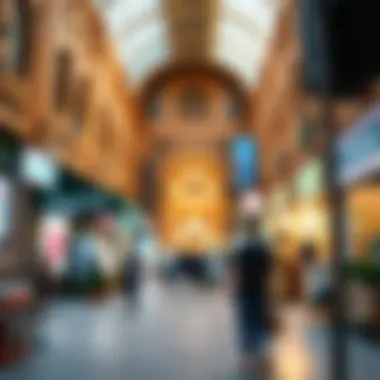

The design of Souk Naif is both practical and aesthetically appealing. With its low-rise buildings and intricate wooden arches, the souk invites shoppers to explore its many narrow passageways. The layout was thoughtfully planned to ensure easy navigation while offering shade from the roaring sun. Soft colors painted on the walls alongside the vibrant hues of the goods create a visual feast that draws both tourists and locals alike.
High ceilings open up spaces, allowing for ventilation, a critical feature given Dubai's climate. These structures showcase traditional Islamic design elements, such as intricate lattice work and geometric patterns, which enhance the marketplace's authenticity. The open-air concept creates an inviting atmosphere, encouraging social interactions among vendors and shoppers.
Integration of Traditional Elements
Traditional architectural elements are interwoven throughout Souk Naif, reflecting the cultural heritage of the region. The use of materials like plaster, wood, and stone in the construction process illustrates ancient building techniques. Take a moment to admire the beautifully crafted wooden doors and window panes.
Additionally, the archways that adorn the entrances represent the grandeur of Islamic architecture. They lead you into a world steeped in history, where every corner tells a story. The deliberate incorporation of local motifs in the decor is another design choice that resonates with visitors, making the space feel like a home instead of just a marketplace.
Modern Touches in Renovations
While preserving its historical roots, Souk Naif has also embraced some modern renovations that enhance its functionality. Recent improvements include upgraded lighting and signage, which make it easier for visitors to navigate the area. Moreover, the addition of fresh paint and renovation of some stalls have added a contemporary flair without overshadowing its traditional essence.
Sustainable practices are becoming increasingly prominent as well, with the introduction of energy-efficient lamps and water-saving fixtures. These modifications do not just aid in keeping the souk lively and relevant; they also show a commitment to merging tradition with responsible development. This blend resonates well with the eco-conscious visitor, ensuring that the cultural fabric of Souk Naif continues to thrive.
"Tradition is not the worship of ashes, but the preservation of fire."
Thus, the architectural aspects of Souk Naif Deira epitomize the delicate interplay between history and modernity, becoming a symbol of Dubai's cultural identity. The rich textures, intricate designs, and thoughtful renovations tell a compelling story, making it a vibrant hub worth visiting.
Shopping Experience
The shopping experience at Souk Naif Deira is a tapestry woven from the threads of culture, tradition, and commerce. This vibrant marketplace is not merely a place to purchase goods; it's an immersive journey through Dubai's rich heritage. As visitors meander through narrow alleys, they encounter a myriad of stalls, each presenting unique products that tell their own stories. The atmosphere buzzes with the sounds of haggling, laughter, and the mingling of different cultures. This section will delve into the various facets of the shopping experience, highlighting what makes Souk Naif a must-visit destination for both tourists and locals.
Variety of Goods Available
At Souk Naif, one can find a plethora of goods that reflect the region's local traditions and global influences. From aromatic spices to intricate textiles, the offerings provide a feast for the senses. Here’s a glimpse of what shoppers can expect:
- Spices and Herbs: Stalls brim with vibrant spices, dried herbs, and exotic blends that tantalize the palate. Locals often seek these ingredients to create authentic Middle Eastern dishes.
- Textiles: Colorful fabrics, including silk and cotton, are available in various patterns and weights. Many vendors sell ready-made garments, while others offer materials for those keen on making their own clothing.
- Traditional Handicrafts: Handmade art pieces, pottery, and jewelry showcase local craftsmanship. These items not only serve decorative purposes but also embody the cultural identity of the Emirate.
- Electronics: While the souk is steeped in tradition, it also caters to modern needs with vendors offering the latest gadgets and tech accessories at competitive prices.
The diversity of products available in Souk Naif serves as a reflection of the economic shifts and cultural interactions that have shaped Dubai's identity over the years.
Souvenir Shopping: What to Look For
For many visitors, finding the perfect souvenir is one of the highlights of their trip. Souk Naif offers an array of souvenirs that capture the essence of Dubai, providing tangible memories of their time spent in this bustling market. Here are some suggestions on what to seek out:
- Traditional Spices: Purchasing saffron or za'atar can be a delightful way to take home a piece of culinary tradition.
- Handwoven Rugs: Nothing says heritage like a handmade rug. These pieces not only beautify a space but also tell stories through their intricate designs.
- Arabic Coffee and Coffee Pots: Many shops sell Arabic coffee along with traditional dallahs, the beautiful coffee pots used for serving.
- Local Artworks: Small paintings and crafts by local artists are not only unique but also support the community.
- Jewelry: Whether it's gold, silver, or precious stones, jewelry from Souk Naif often carries intricate designs that reflect Middle Eastern artistry.
Souvenir shopping in Souk Naif can be more than just a transaction; it’s an opportunity to connect with the culture and support local artisans.
Bargaining Culture and Transaction Norms
An essential aspect of shopping in Souk Naif is the vibrant culture of bargaining. Unlike many supermarkets or retail chains where prices are fixed, haggling is a norm here, transforming the shopping experience into a more engaging interaction with vendors. Here are some insights into this practice:
- Starting Low: It’s common to start negotiations at a much lower price than what the seller initially proposes. This not only sets the tone but also makes the process more exciting.
- Friendly Engagement: Building rapport with vendors often leads to better deals. A simple smile or conversation about the goods can make them more inclined to offer discounts.
- Understanding Value: Knowing the average prices of items beforehand can empower shoppers in negotiations. Researching online or asking locals can provide helpful insights.
- Respect and Etiquette: While bargaining is expected, maintaining respect is critical. Shoppers should remain polite and conscious of the vendor’s livelihood, understanding that haggling is part of the cultural fabric, not a confrontation.
Practicing these bargaining norms can enhance the overall shopping experience, making it a memorable part of visiting Souk Naif.
Visitor Information
Visitor information is indispensable for anyone looking to explore Souk Naif Deira. A clear understanding of practical details can enhance the experience, making it seamless and enjoyable. From knowing when to visit and how to find your way around, to grasping local customs, each element plays a vital role. Here’s a closer look at these significant aspects.
Operating Hours and Accessibility
The souk welcomes visitors at different times through the week, typically buzzing with life from around 10 AM to 10 PM. However, during the Holy Month of Ramadan, operating hours may shift, so it’s wise to check in advance. Accessibility is another key feather in the cap of Souk Naif; it’s conveniently located near several public transport hubs. The Dubai Metro’s Al Ras station is the closest, leading tourists right to the heart of the souk. Those traveling by taxi or car will find designated drop-off areas, easing the journey for visitors. In addition, for anyone who may have mobility concerns, there are ramps available, ensuring that everyone can dive into the market's riches.
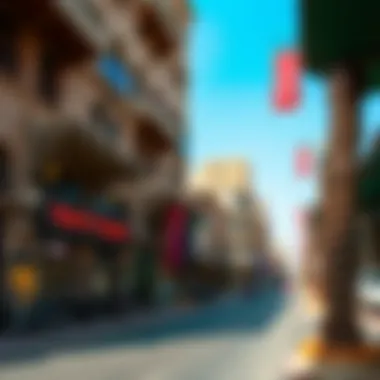

Navigating the Souk: Tips for Tourists
Successfully navigating Souk Naif can be akin to solving a puzzle; familiarity with its layout can enhance the experience. A good strategy is to park yourself at an information desk or look out for signs that delineate pathways and sectors. Don’t hesitate to ask vendors for direction; most are eager to assist and share a story or two.
Additionally, if you want to dart through the narrower lanes, don’t shy away from ambling leisurely to soak up the atmosphere. It’s not just about the shopping; it’s the cultural flavor that is as rich as the items displayed. Here are some quick tips for tourists:
- Wear comfortable footwear; you'll likely be on your feet for a while.
- Keep your personal belongings secure; markets can attract pickpockets.
- Bring a reusable shopping bag to gather your finds.
Local Etiquette and Cultural Considerations
Being respectful of the local customs is paramount when visiting any cultural site. In Souk Naif, men and women alike should dress modestly, keeping in mind that this marketplace reflects the local traditions that are still very much alive today. A friendly smile goes a long way; locals appreciate it when visitors are warm and engaging.
- Greet shopkeepers politely as you enter their stalls. A simple “Salam” or “Hello” can foster goodwill.
- Bargaining is not just accepted, it’s encouraged! However, it's advisable to approach negotiating with a friendly attitude rather than aggressive tactics.
- Keeping your voice down while chatting can help maintain the tranquility of the environment, making the experience more pleasant for everyone.
In summary, understanding visitor information not only eases the journey through Souk Naif but also enriches the cultural experience, allowing for a deeper connection to the vibrant marketplace. For those interested in further information about cultural practices in Dubai, sites like Wikipedia or Britannica can provide valuable insights.
Economic Impact
The economic ramifications of Souk Naif Deira stretch far beyond the mere exchange of goods. At its core, this marketplace serves as a vibrant symbol of the local economy in Dubai, encapsulating the essence of commerce, craftsmanship, and cultural transactions. By investigating this economic impact, we can glean vital insights into the broader commercial landscape and the social fabric of the Emirate.
Role in the Local Economy
Souk Naif is much more than a shopping destination. It acts as a linchpin in the local economy. This bustling marketplace provides jobs for numerous individuals, from vendors to artisans, all of whom play a crucial role in maintaining the vibrancy of the souk.
The marketplace also attracts a considerable number of visitors—both domestic and international—stimulating local businesses. Here’s how it makes waves in the economy:
- Job Creation: Supporting small businesses ensures that there are employment opportunities for many, especially in a region where the job market can be competitive.
- Increase in Foot Traffic: Souk Naif draws numerous tourists, which amplifies consumer spending in nearby establishments, from cafes to hotels.
- Boost for Supporting Industries: The marketplace fuels other sectors like logistics, hospitality, and local tourism, creating a comprehensive economic ecosystem.
Through these pathways, Souk Naif sustains and fuels economic growth, becoming integral to the health of Dubai's commercial scene.
Support for Local Artisans and Vendors
The role that Souk Naif plays in uplifting local artisans and vendors cannot be overstated. It stands as a breeding ground for creativity and entrepreneurship, allowing local talent to flourish. Here are a few key aspects highlighting the support system for these individuals:
- Showcasing Talent: Local artisans find a voice for their craftsmanship here, selling everything from traditional textiles to handmade jewelry. It serves as a canvas to exhibit their skills and share their stories.
- Fair Economic Opportunities: The marketplace allows artisans to set prices that reflect their artistry, fostering an environment where they can thrive economically.
- Community Spirit: Souk Naif fosters a community where artisans network and collaborate, sharing ideas and techniques that enrich their offerings. This sense of camaraderie strengthens the marketplace and is reflected in the diverse goods available.
The importance of this support structure cannot be underestimated, as it doesn't merely provide income; it cultivates a sense of pride and ownership among local makers.
Tourism and Revenue Generation
The relationship between Souk Naif and tourism is quite symbiotic. The marketplace is a major draw for tourists seeking authentic experiences, allowing them to immerse themselves in the local culture and craftsmanship. This influx of visitors directly translates to economic benefits in several ways:
"Tourism isn’t just about the sights; it’s about the experiences that come along with them, and Souk Naif encapsulates that beautifully."
- Expenditure: Tourists often spend generously—not just within the souk but also in surrounding businesses, significantly boosting the local economy.
- Cultural Exchange: By offering visitors a glimpse into the Emirati way of life, Souk Naif enhances Dubai's reputation as a cultural and commercial hub.
- Sustainable Growth: Revenue generated through tourism leads to reinvestment in not only the souk but also infrastructure and community projects, ensuring that both the locals and visitors benefit from growth.
In sum, the economic impact of Souk Naif Deira reverberates throughout every facet of Dubai's commercial landscape, strengthening the community and asserting the importance of preserving this vibrant marketplace.
Cultural Events and Festivals
Cultural events and festivals are the heartbeat of Souk Naif Deira, reflecting its vibrant spirit and deep-rooted traditions. These gatherings not only showcase the unique culture of Dubai but also enhance the overall allure of the marketplace for both residents and tourists. They offer a holistic experience that goes beyond mere shopping, introducing attendees to the essence of Emirati heritage. Furthermore, these events engage the community, fostering a sense of belonging and pride.
Annual Cultural Celebrations
Every year, Souk Naif Deira plays host to a range of annual cultural celebrations that draw crowds from all walks of life. These events, often tied to significant dates in the Islamic calendar or local customs, highlight various aspects of Emirati culture. For example, the Dubai Shopping Festival includes a specific section dedicated to the souk, featuring traditional performances, art showcases, and cuisine tastings.
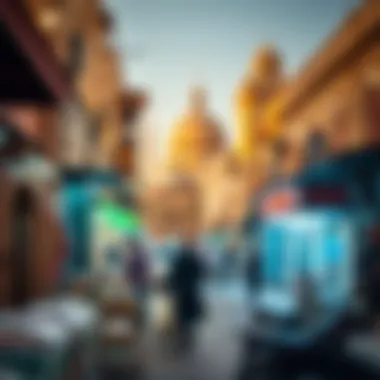

Engaging activities, such as traditional dance performances and poetry readings, provide visitors a chance to immerse themselves in Emirati traditions. The vibrant atmosphere created during these celebrations transforms the souk into a cultural melting pot, inviting tourists to learn about heritage while enjoying the modern-day commercial offerings.
Showcasing Local Heritage
Festivals in Souk Naif Deira also serve as a platform for showcasing local heritage. Artisans from various backgrounds display their crafts, which include handmade jewelry, textiles, and pottery. This part of the festival helps preserve the age-old traditions that have been passed down through generations. It encourages vendors, especially local artisans to tell their stories through their products.
During these events, visitors can participate in workshops aimed at teaching traditional skills like weaving and calligraphy. Such initiatives not only raise awareness about the rich cultural tapestry of the region but also promote sustainability by supporting local crafts and businesses.
"The pulse of the souk is defined by the culture that flows through it, making every visit an opportunity to connect with history."
Art and Performance Initiatives
Art and performance initiatives within Souk Naif have become fundamental to its identity as a commercial hub. By inviting artists to present live demonstrations, the souk embraces both contemporary and traditional art forms. Street performers embellish the cultural scene, offering everything from music to theater snippets that dazzle and captivate audiences.
Moreover, exhibitions often focus on the work of emerging artists, providing them important exposure and reinforcing the souk as a space for creative expression. This back-and-forth between commerce and artistry adds depth to the shopping experience, thereby increasing the overall footfall.
Community involvement is vital; local groups often organize performances, which helps sponsor youth programs or charitable initiatives. Such collaborations breathe life into the souk's character and foster growth that benefits the inhabitants of Deira.
In summary, cultural events and festivals are not merely separate entities within Souk Naif Deira. They are integral to the thriving essence of the marketplace and play a crucial role in bridging the past with the present, creating a memorable experience for all who venture into this captivating hub.
Future of Souk Naif
The future of Souk Naif is a pivotal topic that encapsulates not just the bazaar's potential advancements but also its role as a vessel of cultural continuity amidst the rapid pace of modernization. As Dubai grows, the souk must strive to maintain its authenticity while also adapting to the evolving needs of visitors and traders. Somewhere in this intricate balance lies the opportunity to preserve what makes this marketplace special while enhancing its relevance in an ever-expanding commercial landscape.
Potential Developments and Changes
As the demand for modern amenities and infrastructure increases, several potential developments might occur in and around Souk Naif. This could include:
- Upgraded Facilities: Expect renovations that improve visitor experience without compromising the traditional aesthetic. These modifications may range from better signage to enhanced accessibility features for people with disabilities.
- Digital Integration: The rise of e-commerce has prompted brick-and-mortar stores to drastically enhance their online presence. We might see local vendors developing their e-commerce platforms, allowing them to reach a global audience while retaining the charm of in-person transactions.
- Sustainable Practices: With the world paying more attention to sustainability, initiatives could be put in place to utilize renewable energy, reduce waste, and promote environmentally friendly products made by local artisans.
Such developments may not only improve foot traffic but also enrich the overall shopping experience, attracting a diverse crowd from local denizens to international tourists.
Maintaining Cultural Heritage Amidst Modernization
The greatest challenge Souk Naif faces as it steps into the future is ensuring that modernization doesn't overshadow its rich heritage. Here are some considerations for preserving cultural identity:
- Historical Architecture: Any changes should respect the original architectural elements that characterize the souk. Maintaining traditional features while integrating modern functionality is crucial.
- Cultural Programs: Incorporating cultural performances or workshops that highlight local traditions can reinforce the souk’s identity and educate both visitors and locals. Activities such as craft demonstrations or cooking classes allow for active engagement with the rich heritage.
- Community Involvement: Local stakeholders should play a vital role in any future planning. Strategies designed without input from those who know the souk best—inspectors, traders, and regular visitors—might overlook essential cultural values.
Community Engagement in Future Visions
A critical component of Souk Naif's future will be the active involvement of the community. This engagement can lead to more meaningful enhancements and nurturing of the souk's identity:
- Feedback Mechanisms: Establishing clear channels for feedback allows for ongoing assessments of what works and what doesn’t, ensuring that changes are not just top-down but resonate within the community.
- Collaborative Events: Hosting events that involve local artists, chefs, and artisans can help inject a sense of ownership while drawing more visitors. Events could range from art exhibitions to culinary showcases that celebrate local ingredients.
- Educational Initiatives: Engaging young people through workshops and educational programs focused on local history and crafts can inspire a new generation to appreciate and protect their cultural heritage.
"The strength of any marketplace lies within its community; hence the future of Souk Naif also rests in collective dreams and visions."
The End
In sum, Souk Naif Deira stands as more than just a marketplace; it is a vibrant testament to Dubai's rich tapestry of culture and commerce. The exploration of this souk illustrates its importance within the framework of both economic prosperity and cultural identity. As an investor or developer, understanding the nuances of such hubs can reveal untapped potential in this fast-evolving city.
Key Insights
- Cultural Heritage: Souk Naif is steeped in history, showcasing traditional Emirati lifestyle and crafts that remain relevant today.
- Economic Role: This market plays a pivotal role in the local economy, providing a space for artisans and small merchants to thrive amidst increasing globalization.
- Tourism Impact: The souk is not only a shopping destination but also a cultural site that draws visitors, thereby boosting local businesses and tourism-related ventures.
Moreover, as you navigate through the varied offerings—be it textiles, perfumes, or handicrafts—it becomes clear that each stall is a piece of art, weaving its story into Dubai's larger narrative. To capitalize on the opportunities, one must consider how these cultural intersections can influence purchasing decisions in today’s market.
The preservation of Souk Naif’s essence amid modern changes is a thoughtful task that requires community engagement and innovative strategies. This blend of old and new spells out a future where cultural pride and commercial success can coexist harmoniously.
"Understanding the balance of tradition and modernity in commerce is essential for forging sustainable success in Dubai's marketplace."
For further reading and insights, consider exploring resources from Wikipedia, Britannica, as well as platforms like Reddit. These resources can provide a deeper understanding of the cultural landscape and economic significance of areas like Souk Naif.
